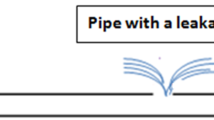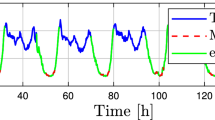Abstract
Leak detection and localization in water pipeline networks is of paramount importance to industry, especially in regions where water is scarce. In this paper, we present a novel multi-modal and multi-scale approach for leak detection and localization in water pipeline networks, in which pressure measurements at various points on the network are used to localize the pipe segment in which the leak is occurring, and then the vibration sensors are used to localize the leak within this segment. In some situations where the complete pipeline model is not available, pressure data alone may not be effective in localizing the leak. However, in such a situation, by supplementing pressure data with vibration data, the leak can be localized, as these additional data are easier to acquire at arbitrary points, since vibration sensors are non-invasive. In order to validate the effectiveness of the approach that needs both pressure and vibration data, we simulate the pipeline model using EPANET that includes models for flow and pressure at various points on the pipeline, then integrate the vibration model with it in MATLAB, since EPNAET does not include models for vibration measurements. A case study of a pipeline network is considered, and the proposed scheme is used to detect and localize the leak. Extensive simulation results show the effectiveness of the proposed scheme in providing accurate leak detection and localization.







Similar content being viewed by others
References
Almeida F, Brennan M, Joseph P et al (2014) On the acoustic filtering of the pipe and sensor in a buried plastic water pipe and its effect on leak detection: an experimental investigation. Sensors (Basel) 14:5595–5610. doi:10.3390/s140305595
Al-Zahrani KH, Baig MB (2011) Water in the Kingdom of Saudi Arabia: sustainable management options. J Anim Plant Sci 21:601–604
Blotter JD, Stephens AG (2004) Flow rate measurements using flow-induced pipe vibration
Brennan MJ, de Lima FK, de Almeida FCL et al (2016) A virtual pipe rig for testing acoustic leak detection correlators: proof of concept. Appl Acoust 102:137–145
Elíades D (2009) EPANET MATLAB Toolkit
Ferrante M, Meniconi S, Brunone B (2014) Local and global leak laws. Water Resour Manag 28:3761–3782
Fuchs HV, Riehle R (1991) Ten years of experience with leak detection by acoustic signal analysis. Appl Acoust 33:1–19
Hunaidi O, Chu WT (1999) Acoustical characteristics of leak signals in plastic water distribution pipes. Appl Acoust 58:235–254. doi:10.1016/S0003-682X(99)00013-4
Ishido Y, Takahashi S (2014) A new indicator for real-time leak detection in water distribution networks: design and simulation validation. Procedia Eng 89:411–417. doi:10.1016/j.proeng.2014.11.206
Kendall MJ, Siviour CR (2014) Rate dependence of poly (vinyl chloride), the effects of plasticizer and time–temperature superposition. In: Proc R Soc A The Royal Society, p 20140012
Martini A, Troncossi M, Rivola A (2014) Vibration monitoring as a tool for leak detection in water distribution networks. Ciri Din:1–9. doi:10.1007/978-3-642-39348-8
Munson B, Young D, Okiishi T, Huebsch W, (2009) Fundamentals of fluid mechanics, 6th Ed
Mysorewala M, Sabih M, Cheded L et al (2015) A novel energy-aware approach for locating leaks in water pipeline using a wireless sensor network and noisy pressure sensor data. Int J Distrib Sens Netw. doi:10.1155/2015/675454
Papastefanou AS, Joseph PF, Brennan MJ (2012) Experimental investigation into the characteristics of in-pipe leak noise in plastic water filled pipes. Acta Acust united with Acust 98:847–856
Pittard MT, Evans RP, Maynes RD, Blotter JD (2004) Experimental and numerical investigation of turbulent flow induced pipe vibration in fully developed flow. Rev Sci Instrum 75:2393–2401
Rossman LA (1999) The EPANET programmer’s toolkit for analysis of water distribution systems. In: WRPMD’99: Preparing for the 21st Century. pp 1–10
Steffelbauer DB, Fuchs-Hanusch D (2016) Efficient sensor placement for leak localization considering uncertainties. Water Resour Manag 30:5517–5533
Stoianov I, Nachman L, Madden S, Tokmouline T (2007) PIPENET: a wireless sensor network for pipeline monitoring. Proc 6th int conf inf process sens networks - IPSN ‘07 264. doi: 10.1145/1236360.1236396
Acknowledgements
The authors would like to acknowledge the support provided by the Deanship of Scientific Research (DSR) at King Fahd University of Petroleum & Minerals (KFUPM) for funding this work through Project no. FT161017.
Author information
Authors and Affiliations
Corresponding author
Rights and permissions
About this article
Cite this article
us Saqib, N., Mysorewala, M.F. & Cheded, L. A Multiscale Approach to Leak Detection and Localization in Water Pipeline Network. Water Resour Manage 31, 3829–3842 (2017). https://doi.org/10.1007/s11269-017-1709-3
Received:
Accepted:
Published:
Issue Date:
DOI: https://doi.org/10.1007/s11269-017-1709-3




